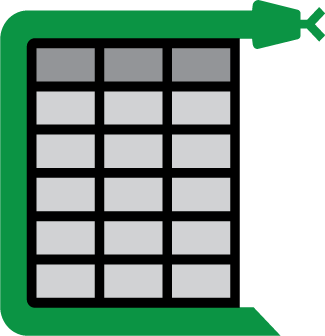Camelot is a Python library that can help you extract tables from PDFs.
Extract tables from PDFs in just a few lines of code:
Try it yourself in our interactive quickstart notebook.
Or check out a simple example using this pdf.
>>> import camelot
>>> tables = camelot.read_pdf('foo.pdf')
>>> tables
<TableList n=1>
>>> tables.export('foo.csv', f='csv', compress=True) # json, excel, html, markdown, sqlite
>>> tables[0]
<Table shape=(7, 7)>
>>> tables[0].parsing_report
{
'accuracy': 99.02,
'whitespace': 12.24,
'order': 1,
'page': 1
}
>>> tables[0].to_csv('foo.csv') # to_json, to_excel, to_html, to_markdown, to_sqlite
>>> tables[0].df # get a pandas DataFrame!
| Cycle Name | KI (1/km) | Distance (mi) | Percent Fuel Savings | |||
|---|---|---|---|---|---|---|
| Improved Speed | Decreased Accel | Eliminate Stops | Decreased Idle | |||
| 2012_2 | 3.30 | 1.3 | 5.9% | 9.5% | 29.2% | 17.4% |
| 2145_1 | 0.68 | 11.2 | 2.4% | 0.1% | 9.5% | 2.7% |
| 4234_1 | 0.59 | 58.7 | 8.5% | 1.3% | 8.5% | 3.3% |
| 2032_2 | 0.17 | 57.8 | 21.7% | 0.3% | 2.7% | 1.2% |
| 4171_1 | 0.07 | 173.9 | 58.1% | 1.6% | 2.1% | 0.5% |
Camelot also comes packaged with a command-line interface!
Refer to the QuickStart Guide to quickly get started with Camelot, extract tables from PDFs and explore some basic options.
Tip: Visit the parser-comparison-notebook to get an overview of all the packed parsers and their features.
Note: Camelot only works with text-based PDFs and not scanned documents. (As Tabula explains, "If you can click and drag to select text in your table in a PDF viewer, then your PDF is text-based".)
You can check out some frequently asked questions here.
- Configurability: Camelot gives you control over the table extraction process with tweakable settings.
- Metrics: You can discard bad tables based on metrics like accuracy and whitespace, without having to manually look at each table.
- Output: Each table is extracted into a pandas DataFrame, which seamlessly integrates into ETL and data analysis workflows. You can also export tables to multiple formats, which include CSV, JSON, Excel, HTML, Markdown, and Sqlite.
See comparison with similar libraries and tools.
The easiest way to install Camelot is with conda, which is a package manager and environment management system for the Anaconda distribution.
conda install -c conda-forge camelot-pyAfter installing the dependencies (tk and ghostscript), you can also just use pip to install Camelot:
pip install "camelot-py[base]"After installing the dependencies, clone the repo using:
git clone https://github.com/camelot-dev/camelot.gitand install using pip:
cd camelot
pip install "."
The documentation is available at http://camelot-py.readthedocs.io/.
- camelot-php provides a PHP wrapper on Camelot.
- camelot-sharp provides a C sharp implementation of Camelot.
The Contributor's Guide has detailed information about contributing issues, documentation, code, and tests.
Camelot uses Semantic Versioning. For the available versions, see the tags on this repository. For the changelog, you can check out the releases page.
This project is licensed under the MIT License, see the LICENSE file for details.



